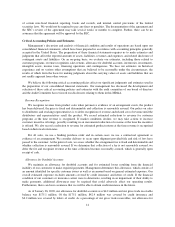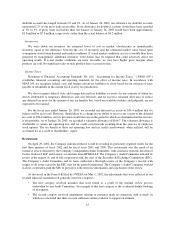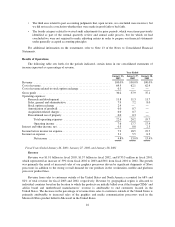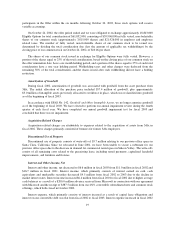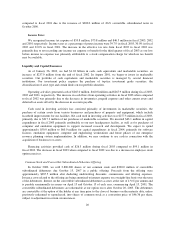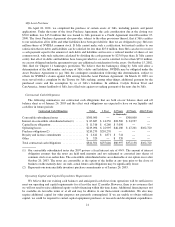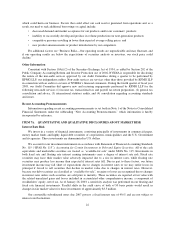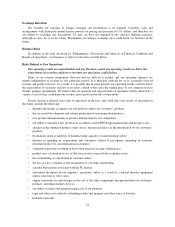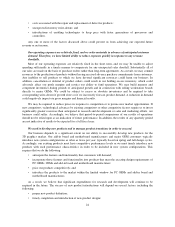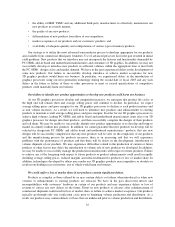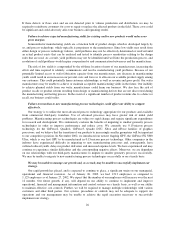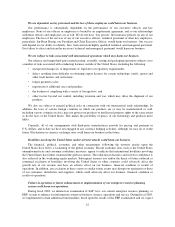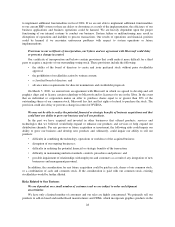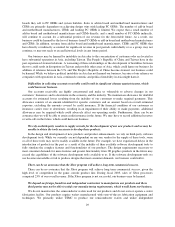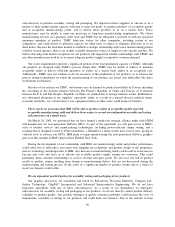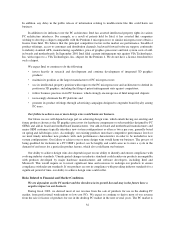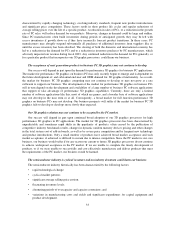NVIDIA 2003 Annual Report Download - page 26
Download and view the complete annual report
Please find page 26 of the 2003 NVIDIA annual report below. You can navigate through the pages in the report by either clicking on the pages listed below, or by using the keyword search tool below to find specific information within the annual report.• costs associated with the repair and replacement of defective products;
• unexpected inventory write-downs; and
• introductions of enabling technologies to keep pace with faster generations of processors and
controllers.
Any one or more of the factors discussed above could prevent us from achieving our expected future
revenue or net income.
Our operating expenses are relatively fixed, and we order materials in advance of anticipated customer
demand. Therefore, we have limited ability to reduce expenses quickly in response to any revenue
shortfalls.
Most of our operating expenses are relatively fixed in the short term, and we may be unable to adjust
spending sufficiently in a timely manner to compensate for any unexpected sales shortfall. Substantially all of
our sales are made on the basis of purchase orders rather than long-term agreements. As a result, we may commit
resources to the production of products without having received advance purchase commitments from customers.
Any inability to sell products to which we have devoted significant resources could harm our business. In
addition, cancellation or deferral of product orders could result in our holding excess inventory, which could
adversely affect our profit margins and restrict our ability to fund operations. We may build memory and
component inventories during periods of anticipated growth and in connection with selling workstation boards
directly to major OEMs. We could be subject to excess or obsolete inventories and be required to take
corresponding write-downs if growth slows or if we incorrectly forecast product demand. A reduction in demand
could negatively impact our gross margins and financial results.
We may be required to reduce prices in response to competition or to pursue new market opportunities. If
new competitors, technological advances by existing competitors or other competitive factors require us to invest
significantly greater resources than anticipated in research and development or sales and marketing efforts, our
business could suffer. Accordingly, we believe that period-to-period comparisons of our results of operations
should not be relied upon as an indication of future performance. In addition, the results of any quarterly period
are not indicative of results to be expected for a full fiscal year.
We need to develop new products and to manage product transitions in order to succeed.
Our business depends to a significant extent on our ability to successfully develop new products for the
3D graphics market. Our add-in board and motherboard manufacturers and major OEM customers typically
introduce new system configurations as often as twice per year, typically based on spring and fall design cycles.
Accordingly, our existing products must have competitive performance levels or we must timely introduce new
products with such performance characteristics in order to be included in new system configurations. This
requires that we do the following:
• anticipate the features and functionality that consumers will demand;
• incorporate those features and functionality into products that meet the exacting design requirements of
PC OEMs, CEMs and add-in board and motherboard manufacturers;
• price our products competitively; and
• introduce the products to the market within the limited window for PC OEMs and add-in board and
motherboard manufacturers.
As a result, we believe that significant expenditures for research and development will continue to be
required in the future. The success of new product introductions will depend on several factors, including the
following:
• proper new product definition;
• timely completion and introduction of new product designs;
24


